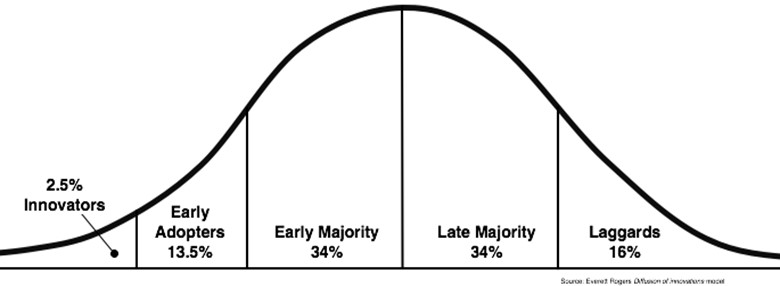I’ve spent over three decades immersed in the nexus of technology and business, including my current role as COO of a bank. In my 32 years of navigating the intricate corridors of fintech startups and traditional banking, I’ve found that culture isn’t just one aspect of the game—it is the game. You can have all the sophisticated technologies and cutting-edge strategies. Still, you’re setting up a glass ceiling above you if you don’t manage to “cross the chasm” in your organisational culture.
The Cultural Quagmire
Imagine a centuries-old oak tree with deep roots and a thick trunk representing a traditional company. This tree is sturdy and grounded, and it’s been weathering storms for years. Change, especially the disruptive kind, threatens to shake this stable foundation. Traditional organisations often view change as a risk rather than an opportunity for growth.
Culture isn’t just about how people talk or dress; it’s about how an organisation “thinks.” It’s the invisible framework shaping everyday decisions. The problem? The majority of traditional companies operate within a mindset resistant to change. This resistance is analogous to the inertia of a rolling boulder; it’s daunting to stop or redirect its course.
The Chameleon of Technology Diffusion
In my journey, thanks to being also a researcher, I have found two crucial theories that I consider the Holy Grail of understanding this challenge. The first is the Technology Diffusion Theory, which in my findings, describes how people adopt new technologies and how to induce change in organisations. Picture it like a bell curve representing your company’s employees. At the far left, you’ve got your Innovators and Early Adopters—the folks ready to embrace new technologies, ideologies, and practices. These are your ‘change champions’ or group of ‘first-followers’. At the far right, you’ve got your Laggards—the ones who resist change until the end. And in between, the Early and Late Majority represent the ‘belly of the bell curve,’ the key demographic you need to swing in favour of change.

Everett Rogers’ seminal work on this theory discusses how innovations gain traction. They start with early adopters and gradually spread through various strata until they become familiar. Technology is the chameleon that can wear the colours of culture, strategy, and transformation, blending seamlessly but making its presence felt forcefully. Just like in the movie “The Matrix,” where Neo has to make a vital decision between the red and blue pill, organisations must also make a choice. The leap from Early Adopters to Early Majority is what Geoffrey A. Moore terms ‘Crossing the Chasm,’ and it’s often the most challenging part of the curve to navigate.
The Push and Pull of Change
The second theory is the ‘Push and Pull Factors Theory’. In simple terms, “push factors” are the circumstances that drive a person (or an organisation) to change. “Pull factors” are the benefits that draw them towards a new condition. For instance, declining revenue could be the “push,” and a streamlined operational framework could be the “pull.” Like in a scene from “Inception,” where Dom Cobb skillfully implants an idea into someone’s mind, you need finesse to balance these factors, especially for the Early and Late Majority. They’ll believe they are being lured into a trap if they see more pull than push. They’ll feel ejected from their comfort zone if they sense more push.
The Digital Alchemy
So, how can we use these theories to bring about a culture change? Here’s the secret sauce:
- Leadership Buy-in: The Golden Key
Think of any memorable scene in a movie where the leader gives an inspiring speech that turns the tide. Mel Gibson in ‘Braveheart’ comes to mind, rallying his troops for a seemingly impossible victory. In any change management effort, leaders are the spearhead. They are the “push” factor that instigates change and the role models that staff look up to for behavioural cues.
- Grassroots Empathy: The Silver Bullet
When I was cutting my teeth in the world of 4 fintech startups, we lived by the mantra, “Customer is King.” Every micro-interaction mattered. Empathy is the “pull” that draws customers and employees into the change vortex. Technology can help amplify this empathy. CRM systems can analyse customer data to understand preferences and pain points, guiding the organisation in becoming more customer-centric.
- Data-Driven Strategies: The Bronze Shield
In a traditional setup, the role of data should be addressed or addressed. However, today’s data is not just the new oil but the soil (in terms of sustainability, it is more like the sun) in which new strategies take root. A cloud-based data analytics system can be your best ally in identifying the areas needing change and measuring new strategies’ effectiveness.
- Risk Mitigation: The Steel Sword
In any battle, warriors have a shield and a sword. If Leadership Buy-in is the shield that protects your change agenda, then Risk Mitigation is the sword that clears your path—leverage technology to measure risk and reward metrics. Machine Learning algorithms can predict potential roadblocks and suggest alternatives before they manifest.
- Collaborate with Technology Partners
Do not see technology as an opponent but as a tag-team partner. Your end goal is the same – organisational effectiveness. Tech companies and internal IT departments should work hand in glove with traditional business departments. Think of them as your Gandalf guiding you through your Lord of the Rings journey, giving you wisdom and lighting your path.
- The Road Ahead: A Marathon, Not a Sprint
The late Peter Drucker said, “Culture eats strategy for breakfast.” I couldn’t agree more. Culture is deeply rooted; it’s not something you can change overnight or with a one-size-fits-all approach. Digital transformation is not just a trending hashtag; it’s a marathon where you must keep your eyes on the long game.
- Regular Checkpoints
Revisit and tweak your strategy at regular intervals. In the digital realm, a strategy effective six months ago might be obsolete today.
- Celebrate Small Wins
Every time a department or individual adopts a new technology or adapts to a new cultural shift, celebrate it. It’s the small battles that win the war.
Bringing it All Together and -Crossing the Chasm’
Here’s the blueprint for ‘crossing the chasms’.
- Identify your Change Champions, your first- followers: Start with the Innovators and Early Adopters. These individuals are your Neo (Matrix)—they choose the red pill willingly. Empower them.
- Leverage Technology: Use analytics and AI algorithms to identify pain points and resistance areas. You can’t manage what you can’t measure.
- Showcase Quick Wins: Just like in “The Pursuit of Happyness,” where Will Smith demonstrates the efficiency of his bone density scanners to gain trust, you, too, should showcase the immediate benefits of the change.
- Engage the Majority: Use balanced Push and Pull factors. Conduct workshops and town halls and actively demonstrate how new methods are better, safer, or more profitable.
- Manage the Laggards: This group aggressively uses push and pull factors to make the status quo seem riskier than the change.
- Iterate: Like any agile process, this isn’t a one-off event but a loop. Regularly revisit and recalibrate your strategies.
- Lead with Empathy: Understand the varying comfort levels with change across the organisation. Tailor your communications and support structures to accommodate this diversity. After all, change management is less about spreadsheets and Gantt charts and more about hearts and minds.
Conclusion: The Digital Master’s Symphony
Organisational culture is a living, breathing entity. And like any living entity, it either evolves or stagnates. Drawing inspiration from the Phoenix, organisations have the potential to rise from their ashes, reborn and rejuvenated through the alchemy of technology and a well-executed cultural change strategy.
Leadership in this journey is not just about steering the ship but being the lighthouse that guides it. Like a ‘Digital Master,’ balance technology and leadership to transform processes and lives. Your tools in this endeavour are as essential as my father considered his artisan tools—handle them with the same level of care, respect, and daily ‘cleaning.’
For those entangled in the decision-making labyrinth, remember the words of Yoda in “Star Wars”—”Do or do not. There is no try.” Now is the time for decision and action.
Change is a marathon, not a sprint, and your ability to balance the push and pull factors to cross the chasm can either make or break your transformation journey. So put on those running shoes, step up to the starting line, and may the force be with you.
The winds of change are blowing, my friends. Either we hoist our sails and catch the breeze, steering our organisations towards new horizons, or anchor ourselves to outdated paradigms and watch opportunities sail by. The choice is yours.
-
Moore, G. A. (1991). "Crossing the Chasm: Marketing and Selling High-Tech Products to Mainstream Customers." [HarperCollins](https://www.harpercollins.com/products/crossing-the-chasm-3rd-edition-geoffrey-a-moore?variant=32207116394562)
-
Rogers, E. M. (2003). "Diffusion of Innovations, 5th Edition." [Simon and Schuster](https://www.simonandschuster.com/books/Diffusion-of-Innovations-5th-Edition/Everett-M-Rogers/9780743222099)











